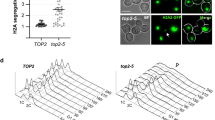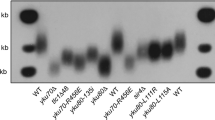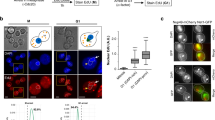Abstract
Telomeres, found at chromosomal ends, are essential for stable maintenance of linear chromosomes in eukaryotes. The ATM family of genes, including budding yeast TEL1 (Refs 1, 2 ), fission yeast rad3+ ( ref. 3 ) and human ATM (ref. 4 ), have been reported to be involved in telomere length regulation5,6,7 although the significance of the telomere phenotypes observed with the mutated genes remains elusive. We have cloned tel1+, another fission yeast ATM homologue, and found that a tel1rad3 double mutant lost all telomeric DNA sequences. Thus, the ATM homologues are essential in telomere maintenance. The mutant grew poorly and formed irregular-shaped colonies, probably due to chromosome instability, however, during prolonged culture of the double mutant, cells forming normal round-shaped colonies arose at a relatively high frequency. All three chromosomes in these derivative cells were circular and lacked telomeric sequences. To our knowledge, this is the first report of eukaryotic cells whose chromosomes are all circular. Upon meiosis, these derivative cells produced few viable spores. Therefore, the exclusively circular genome lacking telomeric sequences is proficient for mitotic growth, but does not permit meiosis.
This is a preview of subscription content, access via your institution
Access options
Subscribe to this journal
Receive 12 print issues and online access
$209.00 per year
only $17.42 per issue
Buy this article
- Purchase on Springer Link
- Instant access to full article PDF
Prices may be subject to local taxes which are calculated during checkout





Similar content being viewed by others
Accession codes
References
Greenwell, P.W. et al. TEL1, a gene involved in controlling telomere length in S. cerevisiae, is homologous to the human ataxia telangiectasia gene. Cell 82, 823–829 (1995).
Morrow, D.M., Tagle, D.A., Shiloh, Y., Collins, F.S. & Hieter, P. TEL1, an S. cerevisiae homolog of the human gene mutated in ataxia telangiectasia, is functionally related to the yeast checkpoint gene MEC1. Cell 82, 831–840 (1995).
Bentley, N.J. et al. TL>The Schizosaccharomyces pombe rad3 checkpoint gene. EMBO J. 15, 6641–6651 ( 1996).
Savitsky, K. et al. A single ataxia telangiectasia gene with a product similar to PI-3 kinase. Science 268, 1749– 1753 (1995).
Dahlén, M., Olsson, T., Kanter-Smoler, G., Ramne, A. & Sunnerhagen, P. Regulation of telomere length by checkpoint genes in Schizosaccharomyces pombe. Mol. Cell. Biol. 9, 611–621 ( 1998).
Metcalfe, J.A. et al. Accelerated telomere shortening in ataxia telangiectasia. Nature Genet. 13, 350–353 (1996).
Lustig, A.J. & Petes, T.D. Identification of yeast mutants with altered telomere structure. Proc. Natl Acad. Sci. USA 83, 1398–1402 (1986).
Singer, M.S. & Gottschling, D.E. TLC1: Template RNA component of Saccharomyces cerevisiae telomerase. Science 266, 404–409 (1994).
Counter, C.M., Meyerson, M., Eaton, E.N.G. & Weinberg, R.A. The catalytic subunit of yeast telomerase. Proc. Natl Acad. Sci. USA 94, 9202–9207 ( 1997).
Lundblad, V. & Blackburn, E.H. An alternative pathway for yeast telomere maintenance rescues est1 – senescence. Cell 73, 347–360 ( 1993).
Sugawara, N. DNA sequences at the telomeres of the fission yeast S. pombe. Thesis, Harvard Univ. (1989).
Mizukami, T. et al. A 13 kb resolution cosmid map of the 14 Mb fission yeast genome by nonrandom sequence-tagged site mapping. Cell 73, 121–132 (1993).
Hoheisel, J.D. et al. High resolution cosmid and P1 maps spanning the 14 Mb genome of the fission yeast S. pombe. Cell 73, 109–120 (1993).
Dingwall, A., Shapiro, L. & Ely, B. Analysis of bacterial genome organization and replication using pulsed-field gel electrophoresis. Methods 1, 160–168 (1990).
Mortimer, R.K., Game, J.C., Bell, M. & Contopoulou, C.R. Use of pulsed-field gel electrophoresis to study the chromosomes of Saccharomyces and other yeasts. Methods 1, 169– 179 (1990).
Hiraoka, Y., Toda, T. & Yanagida, M. The NDA3 gene of fission yeast encodes ß-tubulin: a cold-sensitive nda3 mutation reversibly blocks spindle formation and chromosome movement in mitosis. Cell 39, 349–358 (1984).
Niwa, O. & Yanagida, M. Triploid meiosis and aneuploidy in Schizosaccharomyces pombe: an unstable aneuploid disomic for chromosome III. Curr. Genet. 9, 463– 470 (1985).
Fan, J.B., Rochet, M., Gaillardin, C. & Smith, C.L. Detection and characterization of a ring chromosome in the fission yeast Schizosaccharomyces pombe. Nucleic Acids Res. 20 , 5943–5945 (1992).
Haber, J.E., Thorburn, P.C. & Rogers, D. Meiotic and mitotic behavior of dicentric chromosomes in Saccharomyces cerevisiae. Genetics 106, 185–205 (1984).
Murakami, S., Yanagida, M. & Niwa, O. A large circular minichromosome of Schizosaccharomyces pombe requires a high dose of type II DNA topoisomerase for its stabilization . Mol. Gen. Genet. 246, 671– 679 (1995).
Therman, E. & Susman, M. Human Chromosomes (Springer-Verlag, New York, 1993).
Pandita, T.K., Pathak, S. & Geard, C.R. Chromosome end associations, telomeres and telomerase activity in ataxia telangiectasia cells. Cytogenet. Cell Genet. 71, 86–93 ( 1995).
Chikashige, Y. et al. Telomere-led premeiotic chromosome movement in fission yeast . Science 264, 270–273 (1994).
Chikashige, Y. et al. Meiotic nuclear reorganization: switching the position of centromeres and telomeres in the fission yeast Schizosaccharomyces pombe . EMBO J. 16, 193–202 (1997).
Cooper, J.P., Watanabe, Y. & Nurse, P. Fission yeast Taz1 protein is required for meiotic telomere clustering and recombination. Nature 392, 828–831 (1998).
Nimmo, E.R., Pidoux, A.L., Perry, P.E. & Allshire, R.C. Defective meiosis in telomere-silencing mutants of Schizosaccharomyces pombe. Nature 392, 825– 828 (1998).
McClintock, B. The stability of broken ends of chromosomes in Zea Mays. Genetics 26, 234–282 ( 1941).
Alfa, C., Fantes, P., Hyams, J., McLeod, M. & Warbrick, E. Experiments with Fission Yeast, (Cold Spring Harbor Laboratory Press, Cold Spring Harbor, New York, 1993).
Acknowledgements
We thank E.A. Kamei, T. Shibata and L. Guarente for critical reading of and comments on the manuscript, N. Munakata for γ-ray irradiation experiments and O. Niwa for providing the nda3-KM311 mutant and for helpful discussion. The excellent secretarial work of M. Fukuda is acknowledged. This work was supported by a Grant-in-Aid for Cancer Research and a Grant-in-Aid for Scientific Research on Priority Areas from the Ministry of Education, Science, Sports and Culture of Japan, a Grant-in-Aid of Special Coordination Funds for Promoting Science and Technology from the Science and Technology Agency of Japan and a Grant-in-Aid from the Mitsubishi Foundation. T.N. was supported by a JSPS Research Fellowship for Young Scientists.
Author information
Authors and Affiliations
Corresponding author
Rights and permissions
About this article
Cite this article
Naito, T., Matsuura, A. & Ishikawa, F. Circular chromosome formation in a fission yeast mutant defective in two ATM homologues. Nat Genet 20, 203–206 (1998). https://doi.org/10.1038/2517
Received:
Accepted:
Issue Date:
DOI: https://doi.org/10.1038/2517
This article is cited by
-
Inhibition of MRN activity by a telomere protein motif
Nature Communications (2021)
-
Tpz1TPP1 prevents telomerase activation and protects telomeres by modulating the Stn1-Ten1 complex in fission yeast
Communications Biology (2019)
-
The telomere bouquet regulates meiotic centromere assembly
Nature Cell Biology (2015)
-
A specific family of interspersed repeats (SINEs) facilitates meiotic synapsis in mammals
Molecular Cytogenetics (2013)
-
A single internal telomere tract ensures meiotic spindle formation
EMBO reports (2013)



